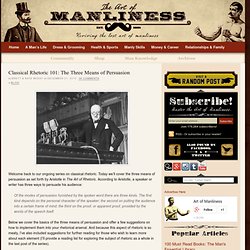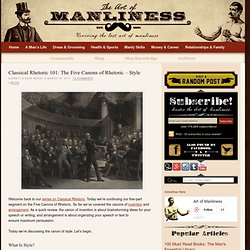

Classical Rhetoric: The Three Means of Persuasion. Welcome back to our ongoing series on classical rhetoric.

Today we’ll cover the three means of persuasion as set forth by Aristotle in The Art of Rhetoric. According to Aristotle, a speaker or writer has three ways to persuade his audience: Of the modes of persuasion furnished by the spoken word there are three kinds. The first kind depends on the personal character of the speaker; the second on putting the audience into a certain frame of mind; the third on the proof, or apparent proof, provided by the words of the speech itself.
Below we cover the basics of the three means of persuasion and offer a few suggestions on how to implement them into your rhetorical arsenal. Ready to get started? Ethos: The Appeal to the Speaker’s or Writer’s Character or Reputation If you wish to persuade, you need to establish credibility and authority with your audience. A speaker or writer can use ethos in several ways. Renaissance Man: How to be a Real Polymath. Every man should strive to reach his full potential.

The competitive world in which we live stresses hyper-specialization as the way to get ahead. University graduate degrees narrow down a student’s area of expertise to enable them fill a specific niche. Young boys are encouraged to choose a single sporting event in which they excel if they are to have any hope for a collegiate or professional career down the road. Sadly, this trend is slowly eliminating the once-popular aspiration of becoming a well-rounded man.
A gentleman should have a firm handle on not just one or two, but every aspect of his humanity, working to strengthen himself in every way possible. The ideal of the Renaissance Man originated in Italy, and is based on the belief that a man’s capacity for personal development is without limits; competence in a broad range of abilities and areas of knowledge should be every man’s goal and is within every man’s grasp. Knowledge Physical Development Social Accomplishments Arts. Classical Rhetoric 101: The Five Canons of Rhetoric – Invention. Welcome back to our series on Classical Rhetoric.

Today we’re kicking off a five-part segment on the Five Canons of Rhetoric. As you remember from our brief introduction to classical rhetoric, the Five Canons of Rhetoric constitute a system and guide on crafting powerful speeches and writing. It’s also a template by which to judge effective rhetoric. The Five Canons were brought together and organized by the Roman orator Cicero, in his treatise, De Inventione, written around 50 BC. 150 years later in 95 AD, the Roman rhetorician Quintilian explored the Five Canons in more depth in his landmark 12-volume textbook on rhetoric, Institutio Oratoria. Five Canons of Rhetoric: Arrangement.
Welcome back to our series on Classical Rhetoric.

Today we’re continuing our five-part segment on the Five Canons of Rhetoric. Last time we discussed invention, which is essentially brainstorming and planning your speech or writing. In this installment, we’ll be exploring the canon of arrangement. Let’s get started. What Is Arrangement? Arrangement is simply the organization of a speech or text to ensure maximum persuasion. Introduction (exordium)Statement of Facts (narratio)Division (partitio)Proof (confirmatio)Refutation (refutatio)Conclusion (peroratio) If you’ve taken debate or philosophy classes, you’ve probably seen this format for organizing a speech or paper. 1. There are two aspects of an effective introduction: 1) introducing your topic and 2) establishing credibility. Introducing your topic. Classical Rhetoric: An Introduction. As many of you know, I read a lot of biographies on the lives of great men from history.

The part of a man’s life I enjoy learning about the most is their education. What books did they read as young men that influenced them later on in life? Where did they travel? What classes did they take while at university? I’ll take notes on these things and try to incorporate their favorite books into my reading list or pick-up an audio course at the library that correlates to a subject they studied.
One thing I’ve noticed about my manly heroes is they all took courses in rhetoric at some point during their education. But in the early part of the 20th century, a shift in education occurred. Which is quite unfortunate. Our economy and society in the West in general are becoming increasingly knowledge and information based; the ability to communicate effectively and persuasively is more essential to success than ever before. Classical Rhetoric 101: The Five Canons of Rhetoric- Memory.
Five Canons of Rhetoric: Style. Welcome back to our series on Classical Rhetoric.

Classical Rhetoric 101: The Five Canons of Rhetoric-Delivery. Demosthenes practicing his delivery by the ocean.

Welcome back to our series on Classical Rhetoric. Today we’re continuing our five-part segment on the Five Canons of Rhetoric. So far we’ve covered the canons of invention, arrangement, style, and memory. Today we’ll be covering the last canon: delivery. What Is Delivery?